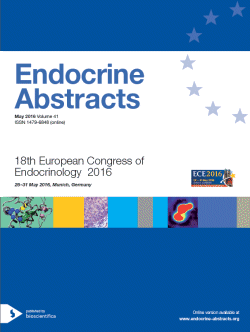Guided Posters
Cardiovascular endocrinology
ea0041gp51 | Cardiovascular endocrinology | ECE2016
Pericardial rather than intramyocardial fat is independently associated with systolic and diastolic left ventricular heart function in metabolically healthy humans
Wolf Peter , Winhofer Yvonne , Smajis Sabina , Jankovic Drazenka , Anderwald Christian-Heinz , Trattnig Siegfried , Luger Anton , Krebs Michael , Krssak Martin
ea0041gp52 | Cardiovascular endocrinology | ECE2016
Sex specific effects of alterations in macronutrient composition on fat accumulation, lipid-synthesis, -transport and –storage
Andersen Kirstin , Kavermann Larissa , Horngacher Amon , Tom Robby Zachariah , Sachs Stephan , Hofmann Susanna , Bidlingmaier Martin
ea0041gp53 | Cardiovascular endocrinology | ECE2016
Different repletion of intramyocellular lipid (IMCL) in patients with growth hormone deficiency (GHD) compared to control subjects (CS) 24 h after a 2-h aerobic exercise
Jenni Stefan , Loher Hannah , Bucher Julie , Ith Michael , Boesch Chris , Kreis Roland , Christ Emanuel R
ea0041gp54 | Cardiovascular endocrinology | ECE2016
Oxytocin signalling involved in cardiac protection against ischemia reperfusion
Jankowski Marek , Ryes Araceli Gonzales , Menouar Ahmed , Gutkowska Jolanta
ea0041gp55 | Cardiovascular endocrinology | ECE2016
IGF-1: A marker of cardio-metabolic risk in obstructive sleep apnea (OSA) syndrome?
Pepin JL , Galerneau LM , Borel AL , Chabre O , Sapene M , Stach B , Girey-Rannaud J , Tamisier R , Caron Ph
ea0041gp56 | Cardiovascular endocrinology | ECE2016
The dual FXR/TGR5 agonist INT-767 reduces visceral fat mass, promoting preadipocyte brown differentiation, mitochondrial function and insulin sensitivity in a rabbit model of high fat diet-induced metabolic syndrome
Vignozzi Linda , Cellai Ilaria , Filippi Sandra , Comeglio Paolo , Mello Tommaso , Bani Daniele , Guasti Daniele , Sarchielli Erica , Morelli Annamaria , Maneschi Elena , Vannelli Gabriella Barbara , Adorini Luciano , Maggi Mario
ea0041gp57 | Cardiovascular endocrinology | ECE2016
Prioritizing drug targets for non-alcoholic fatty liver disease based on comorbidity network analysis
Nguyen Thanh-Phuong , Sauter Thomas , Caberlotto Laura , Lammert Frank , Schneider Jochen G
ea0041gp58 | Cardiovascular endocrinology | ECE2016
Cardiac status after long-term growth hormone replacement therapy in adult growth hormone deficient patients. A single centre audit based on echocardiographic investigations before and during GH replacement therapy
Skoglund Sissela , Rasmussen Ulla Feldt , Klose Marianne , Hassager Christian
ea0041gp59 | Cardiovascular endocrinology | ECE2016
Familial partial lipodystrophy type 3 due to PPARgamma mutation: presentation with diabetes and severe hypertriglyceridemia
Oliveira Joana , Cunha Filipe , Rodrigues Elisabete , Menezes Joana , Saavedra Ana , Costa Maria Manuel , Magalhaes Daniela , Bettencourt-Silva Rita , Fernandes Susana , Oliveira Joao Paulo , Carvalho Davide , Freitas Paula




